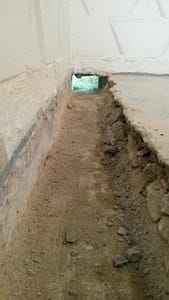Some Ideas on Best Basement Waterproofing You Should Know
Table of ContentsSee This Report about Best Basement WaterproofingBest Basement Waterproofing - TruthsThe 5-Minute Rule for Best Basement WaterproofingThe Main Principles Of Best Basement Waterproofing The 15-Second Trick For Best Basement Waterproofing
AdvantaClean's qualified specialists and service technicians will certainly find the water resource. If wall or slab cracks are present, we will inject polyurethane and epoxies right into the splits and secure the concession, stopping additional wetness from going into.
If there's condensation outside of the aluminum foil, you have high moisture in your cellar. Repair it with a portable area dehumidifier or a whole-house humidifier system rather than waterproofing products. If the foil has condensation on the inside surface (following to the wall surface), the dirt around your residence may be naturally damp from a high water table or bad soil water drainage.
You can waterproof just your interior walls, which might solve the problem. Once they dry, they adhere permanently to concrete and masonry walls.
Some Known Questions About Best Basement Waterproofing.
Swirl the brush at the last phase of application to offer the wall an appealing, finished appearance. Concrete waterproof finishes can't be put on previously painted surfaces; examine the tag. A 5-gallon container expenses regarding $60. Also called densifiers, they appropriate only for wall surfaces that haven't been repainted or secured.
Yet you comb, roll, or spray it on a lot more heavily one gallon covers just 75 square feet, not the 300 square feet regular with common paint. Water-proof paint is fine for DIY application. You can use it over painted surfaces, and paint over it once it's treated (one gallon expenses $37).
It can cost $10,000 to $15,000, depending on the job needed. Exterior waterproofing involves excavating all around the home to the complete deepness of the foundation walls, then setting up a water resistant coating or membrane layer topped by drainage panels.
A basement without waterproofing is kind of like that. Your basement doesn't want to go through a rainstorm without correct protection just as much as you don't want to.
The 5-Minute Rule for Best Basement Waterproofing
Yet if you have actually done your research, you 'd know there are 2 types of waterproofing: exterior and interior. It can obtain puzzling what they both mean, which one's a better investment, and what will actually maintain the water out. Do not worry, we put with each other this blog to quickly specify both techniques for you and talk about the benefits and drawbacks of each.
Exterior waterproofing is a waterproofing approach that entails securing your home from the exterior. It's kind of like a moat around a castle. It involves digging a trench around your whole home to the foundation (about 8 to 10 feet down). The structure walls are then cleansed, sealed, and covered with a water-proof membrane layer or sealant.
The Only Guide to Best Basement Waterproofing
It's a much more engaged process that calls for excavating up your lawn, which is costly and go time-consuming. Exterior waterproofing entails eliminating whatever surrounding the home, consisting of why not try these out porches, driveways, sidewalks, landscaping, a/c units, decks, and so forth. If any of the job was done improperly and water is still entering your basement, there isn't much you can do to remedy or repair it.
Inside basement waterproofing includes waterproofing from the inside. Any water that leaks right into your basement is redirected before it touches your flooring. It's kind of like using a raincoat under your garments. It includes 2 things: a water drainage track and a sump pump. It functions by sealing the within of your basement walls and floors so water that attempts to get in is directed out through a sump pump.
It's an efficient approach to waterproof your basement. The drawback of interior cellar waterproofing mainly has to do with the helpful site installment procedure.
Best Basement Waterproofing Things To Know Before You Get This
In final thought, exterior and indoor basement waterproofing are both reliable approaches of shielding your home from water damage. Exterior waterproofing develops an obstacle that avoids water from entering your home, while indoor waterproofing reroutes water that does enter your home. And it is very important to keep in mind that exterior waterproofing is a pricey and disruptive installation procedure when compared to indoor waterproofing.
Whichever method you select, make sure you select a trustworthy and credible contractor for the job. Both techniques require experienced employees to take care of the work. If you have any type of concerns concerning cellar waterproofing, please connect to us. And if you're in our service location and have water in your cellar, contact us for a complimentary, no-obligation home examination.
You can complete our kind here, start a conversation in the bottom right-hand corner, or call us at 1-800-827-0702.